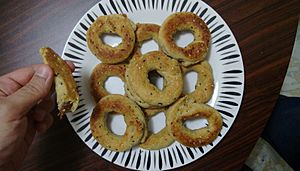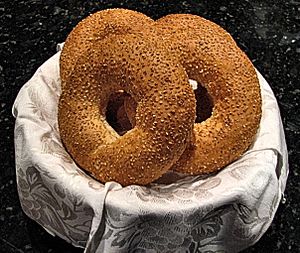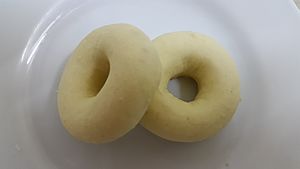Ka'ak facts for kids
 |
|
| Course | Pastry |
|---|---|
| Region or state | Middle East, Persia |
| Main ingredients | Wheat flour, Vegetable oil, Eggs, Sugar, Black cumin or Sesame seeds, Egg yolk, Water, and Salt |
Ka'ak (pronounced "kah-ak") is an Arabic word for a type of baked good. It's like a biscuit or a pastry. You can find many different kinds of Ka'ak all over the Arab world and the Near East. In the Middle East, it's often a dry, ring-shaped bread. A similar pastry called "kue kaak" is also popular in Indonesia.
Contents
The History of Ka'ak
Ka'ak first appeared in a book called Kitab al Wusla il al Habib. This book was written in Syria in the 13th century. It even included three different recipes for Ka'ak.
Types of Ka'ak Pastries
Ka'ak Bread Rings
One type of Ka'ak is a large, ring-shaped bread. It is usually covered with sesame seeds. People often eat it as a snack or for breakfast. They might have it with za'atar, which is a mix of herbs and spices.
In East Jerusalem, this bread is sometimes served with baked eggs and falafel. Palestinian people think ka'ak al-Quds (Jerusalem ka'ak) is very special. They often buy it as a gift for friends and family outside the city.
In Lebanon, Ka'ak bread rings are made from sweet dough. They are shaped into rings and topped with sesame seeds. After baking, they are sometimes glazed with milk and sugar. Tunisian Jews also make a sweet and salty version. In Egypt, a type with almonds, called kahk bi loz, is served at weddings.
Sweet Ka'ak Cookies

Many sweet Ka'ak are cookies made from semolina. Some popular kinds include:
- Ka'ak bi ma'moul (or ka'ak bi ajwa): These are filled with ground dates.
- Ka'ak bi jowz: These have a filling of ground walnuts.
- Ka'ak bi fustok: These are stuffed with ground pistachios.
In Egypt, these sweet cookies are called kahk. They are very popular during Eid al-Fitr and Easter. Kahk are often covered in powdered sugar. They can be filled with honey and nuts, Turkish delight, walnuts, pistachios, or dates. Some are simply plain. People also decorate them with beautiful designs. Egyptians have been making kahk for a very long time, since the Eighteenth Dynasty of Ancient Egypt, about 3,500 years ago.
Arab Christians, especially Palestinian Christians and Lebanese Christians, make these sweets for Easter. The cookies are often shaped like wreaths. This shape reminds them of the crown of thorns that Jesus of Nazareth wore.
For Muslim holidays like Eid al-Fitr and Eid al-Adha, ka'ak bi ma'moul is a traditional dessert. In Gaza, if a neighbor sends you food during holidays, it's polite to send back a dish of your own. Often, this dish is filled with ka'ak bi ajwa. These Ka'ak sweets are made all year by Palestinian people. Sometimes, they use regular flour instead of semolina.
Ka'ak al-asfar (meaning "the yellow roll") is a special bread. Muslims in the Levant make it to honor people who have passed away. This bread often has a detailed design stamped on it. Traditionally, it was given to the poor, children, and relatives. This happened on certain days after someone died. An old bread stamp used for these cakes was found in Palestine. It is from the 14th or 15th century.
Iraqi Ka'ak sweets are usually shaped like doughnuts. They are covered in sesame seeds. One type is ka'ak ab sumsum. Another is ka'ak eem tzmukin, which has raisins. Ka'ak beharat oo tefach is similar but uses apples instead of raisins. It is coated in almonds. In Yemen, Ka'ak was traditionally made with a little black cumin. It was a traditional pastry for the Jews of Yemen during the holiday of Purim.
See also
 In Spanish: Kaʿak para niños
In Spanish: Kaʿak para niños



